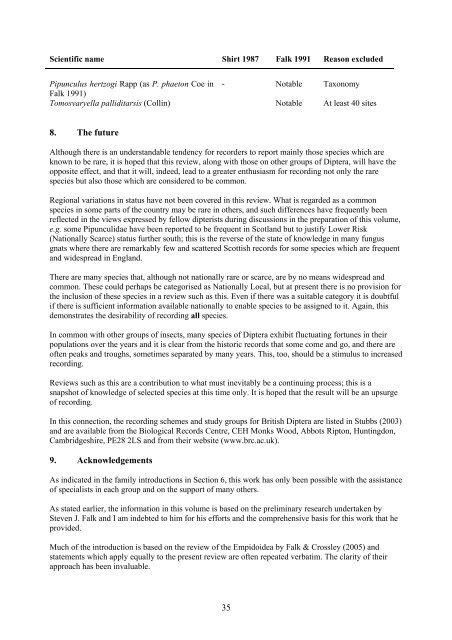Part 2: Nematocera and Aschiza not dealt with by Falk (1991) - JNCC
Part 2: Nematocera and Aschiza not dealt with by Falk (1991) - JNCC
Part 2: Nematocera and Aschiza not dealt with by Falk (1991) - JNCC
Create successful ePaper yourself
Turn your PDF publications into a flip-book with our unique Google optimized e-Paper software.
Scientific name Shirt 1987 <strong>Falk</strong> <strong>1991</strong> Reason excluded<br />
Pipunculus hertzogi Rapp (as P. phaeton Coe in - Notable Taxonomy<br />
<strong>Falk</strong> <strong>1991</strong>)<br />
Tomosvaryella palliditarsis (Collin) Notable At least 40 sites<br />
8. The future<br />
Although there is an underst<strong>and</strong>able tendency for recorders to report mainly those species which are<br />
known to be rare, it is hoped that this review, along <strong>with</strong> those on other groups of Diptera, will have the<br />
opposite effect, <strong>and</strong> that it will, indeed, lead to a greater enthusiasm for recording <strong>not</strong> only the rare<br />
species but also those which are considered to be common.<br />
Regional variations in status have <strong>not</strong> been covered in this review. What is regarded as a common<br />
species in some parts of the country may be rare in others, <strong>and</strong> such differences have frequently been<br />
reflected in the views expressed <strong>by</strong> fellow dipterists during discussions in the preparation of this volume,<br />
e.g. some Pipunculidae have been reported to be frequent in Scotl<strong>and</strong> but to justify Lower Risk<br />
(Nationally Scarce) status further south; this is the reverse of the state of knowledge in many fungus<br />
gnats where there are remarkably few <strong>and</strong> scattered Scottish records for some species which are frequent<br />
<strong>and</strong> widespread in Engl<strong>and</strong>.<br />
There are many species that, although <strong>not</strong> nationally rare or scarce, are <strong>by</strong> no means widespread <strong>and</strong><br />
common. These could perhaps be categorised as Nationally Local, but at present there is no provision for<br />
the inclusion of these species in a review such as this. Even if there was a suitable category it is doubtful<br />
if there is sufficient information available nationally to enable species to be assigned to it. Again, this<br />
demonstrates the desirability of recording all species.<br />
In common <strong>with</strong> other groups of insects, many species of Diptera exhibit fluctuating fortunes in their<br />
populations over the years <strong>and</strong> it is clear from the historic records that some come <strong>and</strong> go, <strong>and</strong> there are<br />
often peaks <strong>and</strong> troughs, sometimes separated <strong>by</strong> many years. This, too, should be a stimulus to increased<br />
recording.<br />
Reviews such as this are a contribution to what must inevitably be a continuing process; this is a<br />
snapshot of knowledge of selected species at this time only. It is hoped that the result will be an upsurge<br />
of recording.<br />
In this connection, the recording schemes <strong>and</strong> study groups for British Diptera are listed in Stubbs (2003)<br />
<strong>and</strong> are available from the Biological Records Centre, CEH Monks Wood, Abbots Ripton, Huntingdon,<br />
Cambridgeshire, PE28 2LS <strong>and</strong> from their website (www.brc.ac.uk).<br />
9. Acknowledgements<br />
As indicated in the family introductions in Section 6, this work has only been possible <strong>with</strong> the assistance<br />
of specialists in each group <strong>and</strong> on the support of many others.<br />
As stated earlier, the information in this volume is based on the preliminary research undertaken <strong>by</strong><br />
Steven J. <strong>Falk</strong> <strong>and</strong> I am indebted to him for his efforts <strong>and</strong> the comprehensive basis for this work that he<br />
provided.<br />
Much of the introduction is based on the review of the Empidoidea <strong>by</strong> <strong>Falk</strong> & Crossley (2005) <strong>and</strong><br />
statements which apply equally to the present review are often repeated verbatim. The clarity of their<br />
approach has been invaluable.<br />
35
















